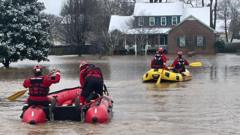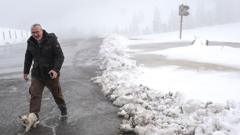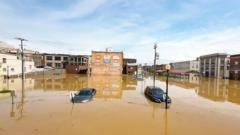Over the weekend, torrential rains in southeastern US states, particularly Kentucky, led to nine fatalities, widespread flooding, and power outages as officials warn of ongoing dangers and prepare for federal disaster response.
Devastating Floods Claim Lives in Southeastern US Amid Storm Warnings

Devastating Floods Claim Lives in Southeastern US Amid Storm Warnings
At least nine individuals have died in severe floods caused by heavy rain in multiple states, prompting emergency declarations and rescue operations.
At least nine people have lost their lives over the weekend due to severe flooding triggered by torrential downpours in the southeastern United States. Kentucky experienced the most devastation, reporting eight fatalities, according to Governor Andy Beshear, who cautioned at a news conference on Sunday that this number might rise as rescue operations continue. The ninth death occurred in Georgia, where an uprooted tree crashed into a man's home while he slept.
The inundation followed catastrophic damage wrought by Hurricane Helene in September, as parts of Kentucky received nearly 6 inches (15 cm) of rain, leading to rapid river level rises and widespread roadway submersion. Photos from the scene depict vehicles trapped in deep waters, raising significant concerns over public safety. Governor Beshear advised residents to refrain from road travel to ensure their safety.
In response to the crisis, President Donald Trump approved an emergency disaster declaration on Sunday, enabling the Federal Emergency Management Agency (Fema) to manage relief efforts. The high level of damage and loss of life has necessitated coordinated rescue operations, with hundreds of individuals successfully rescued from flood-locked conditions.
Multiple southeastern states, including Kentucky, Georgia, Alabama, Mississippi, Tennessee, Virginia, West Virginia, and North Carolina, remain under storm-related alerts. The recent weather patterns have exacerbated existing flood conditions, with officials indicating that many rivers are still expected to rise.
In Tennessee, the flooding has been particularly acute in areas like Obion County, where heavy rains caused a levee breach, prompting urgent warnings for locals to reach higher ground. The mayor of Rives, a small-town community in the region, declared a state of emergency and ordered mandatory evacuations due to life-threatening conditions.
With states like West Virginia also declaring states of emergency, Governor Patrick Morrisey emphasized the need for caution among residents, while Kristi Noem, the head of the Department of Homeland Security, confirmed that the federal government is poised to offer support to state authorities.
Meteorological forecasts suggest that cold weather from a polar vortex may soon affect the northern Rockies and Plains regions, potentially bringing extreme low temperatures to areas like Colorado and Denver, which has activated shelters for its homeless population in anticipation of harsh conditions. The interplay of severe weather and ongoing flood management underscores the need for comprehensive disaster preparedness as emergencies continue to unfold across the southeastern United States.




















